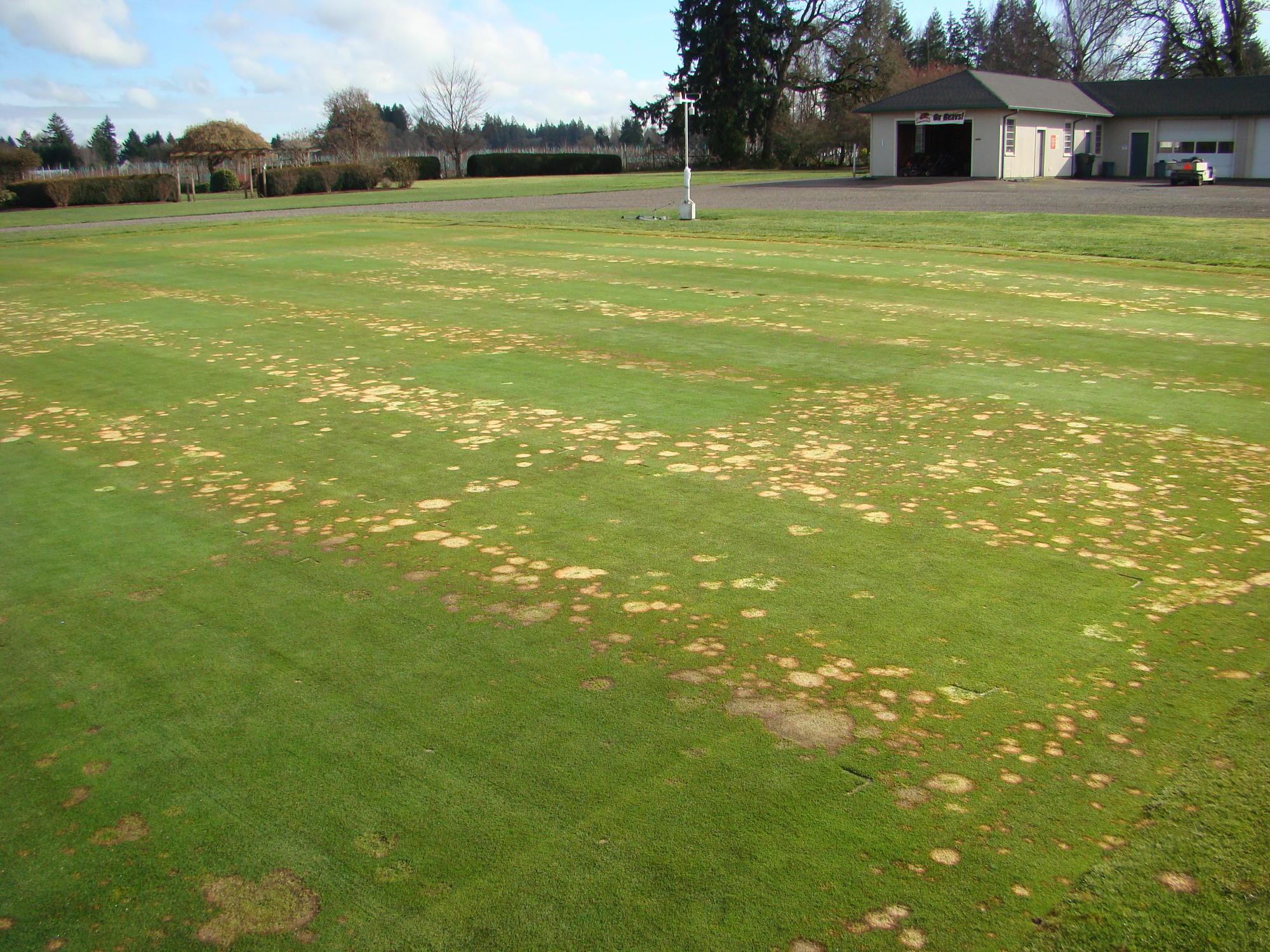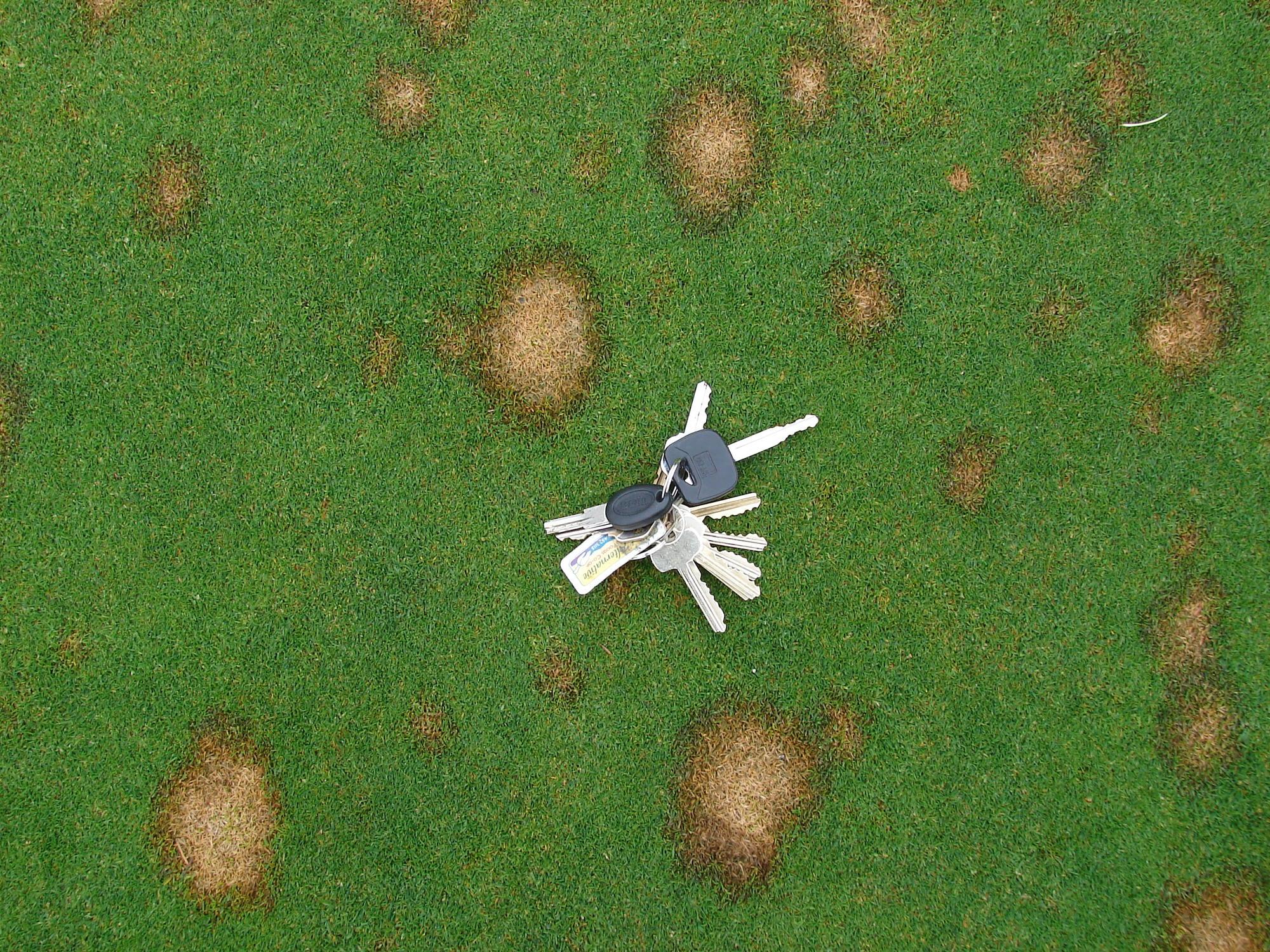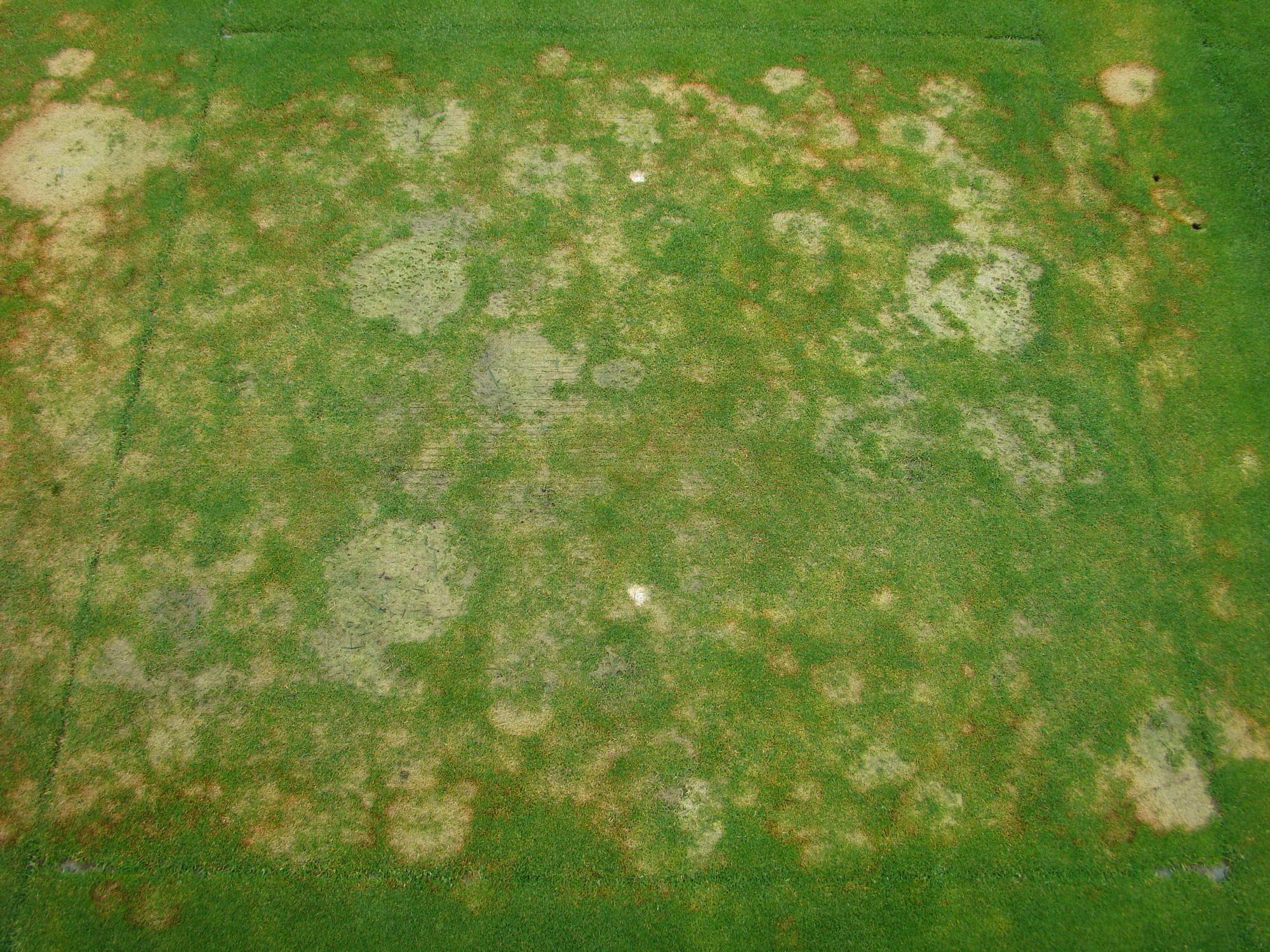Microdochium patch is a turfgrass disease caused by the fungal pathogen Microdochium nivale. It occurs in cool and humid environments. These conditions are common during fall and winter in the Pacific Northwest.
Microdochium patch affects most turfgrass species grown in this region. Even though damage from Microdochium patch can be dramatic, in most cases the turfgrass recovers when temperatures rise.
How you manage Microdochium patch depends on your level of expectation for the turfgrass in spring. Managers of professional sports fields and golf courses are likely to dedicate more resources than the typical homeowner.
Signs of Microdochium patch typically develop during wet weather in the fall, winter and spring. They occur when temperatures are below 60°F but above freezing. Signs include a small ring of white or pink-colored mycelium (fungal growth). Symptoms include tan or reddish-brown turf within the mycelium ring.
Managing golf course greens
Annual bluegrass is the dominant turfgrass on golf course putting greens, tees and fairways in cool, humid regions of the Pacific Northwest. This species is particularly susceptible to Microdochium patch. Creeping bentgrass is genetically more resistant to Microdochium patch than annual bluegrass. But annual bluegrass outcompetes creeping bentgrass in the cool, humid climate of western Oregon.
One way to control Microdochium patch on golf course putting greens is to reduce fall and winter nitrogen applications. Apply no more than 0.1 lbs. N per 1,000 square feet every two weeks.
While dew removal is important in the management of several turfgrass diseases, research suggests that it plays a limited role in reducing Microdochium patch. There are various methods of removing dew. Rolling putting greens provides greater suppression of Microdochium patch than more traditional practices, such as using a dew brush.
Fungicides are effective at suppressing Microdochium patch. However, some strains of Microdochium nivale have demonstrated resistance to dicarboximides (such as 26GT), quinone outside inhibitors (such as Heritage, Insignia and Compass) and methyl benzimidazole carbamates (3336, for example). Rotate fungicides to avoid resistance. For updates on fungicide effectiveness, see Chemical Control of Turfgrass Disease. Table 1 lists an example fungicide rotation to control Microdochium patch developed at Oregon State University.
| Date | Product | Rate (oz./1,000ft2) | Active ingredients | Group |
|---|---|---|---|---|
| Sep. 15 | Headway | 3.0 | Propiconazole + Azoxystrobin | 3, 11 |
| Oct. 15 | Turfcide 400 | 8.0 | PCNB | 14 |
| Nov. 15 | Instrata | 7.0 | Chlorothalonil + Propiconazole + Fludioxonil | 12, 3, M |
| Dec. 15 | Affirm + Secure | 0.9 + 0.5 | Polyoxin D + Fluazinam | 19, 29 |
| Jan. 15 | Turfcide 400 + 26GT | 4.0 + 4.0 | PCNB + Iprodione | 14 |
| Feb. 15 | Instrata | 7.0 | Chlorothalonil + Propiconazole + Fludioxonil | 12, 3, M |
| March 15 | Interface + FORE | 5.0 + 8.0 | Iprodione + Trifloxystrobin+ Mancozeb | 2, 11, M3 |
| April 15 | Contend A | 1.0 | Benzovinduiflupyr (SDHI) + Difenoconazole | 7, 3 |
Oregon State University has researched alternatives to traditional fungicide programs to suppress Microdochium patch on annual bluegrass putting greens. This research suggests that it is possible to suppress Microdochium patch with a combination of mineral oil, sulfur and phosphorous acid. Table 2 lists a few options that have been effective in Corvallis, Oregon.
| Date | Product | Rate (oz./M) | Group |
|---|---|---|---|
| Putting green Option 1: Research demonstrates this rotation suppresses disease similar to traditional fungicides | |||
| Sept. 1 and repeated every 28 days | Civitas Turf Defense + phosphorous acid | 8.5 oz./M + 0.075 lbs. H3PO3 / M | Not classified, P 07 (33) |
| Sept. 15 and repeated every 28 days | Sulfur + phosphorous acid | 0.25 lbs./M, | M 02 |
| 0.075 lbs. H3PO3 / M | P 07 (33) | ||
| Putting green Option 2: Base program options followed by scouting and treating when necessary | |||
| Sept. 1, then repeat every 14 days in Sept., Oct., Nov. and April | Civitas Turf Defense* + phosphorous acid | 8.5 oz./M + | Not classified, |
| 0.075 lbs. H3PO3 / M | P 07 (33) | ||
| Every 14 days, December–March | Sulfur + phosphorous acid | 0.25 lbs./M | M 02 |
| 0.075 lbs. H3PO3 / M | P 07 (33) | ||
| Lower value sites that can tolerate some turfgrass thinning (perhaps tees, approaches, fairways) | |||
| Sept. 1 and repeated every 14 days | FeSO4 • 7H2O | 0.5 lbs. of product / M | N/A |
| phosphorous acid | 0.075 lbs. H3PO3 / M | P 07 (33) | |
* Avoid repeated, frequent applications (every 14 days) of Civitas Turf Defense during the winter months.
Managing general purpose lawns
Prevent Microdochium patch by selecting the right species of turfgrass. Home lawn species that are less susceptible to Microdochium patch include perennial ryegrass, colonial bentgrass and fine fescue. Reports indicate that hard fescue and strong creeping red fescue are more resistant than Chewings fescue. Kentucky bluegrass and tall fescue, on the other hand, grow slowly in the winter and are particularly susceptible to this disease.
Most lawns composed of less susceptible species fully recuperate from Microdochium patch damage in late spring. Using fungicides to manage this disease is almost never warranted, unless you can’t tolerate damage prior to warm spring temperatures.
Cultural controls in general purpose lawns include mowing, leaf removal and avoiding high fall nitrogen fertilizer rates (greater than 1 lb. of nitrogen per 1,000 sq. ft. per month). Nitrogen encourages growth and lush leaf tissue that is more susceptible to fungal pathogens. Keep in mind that other fungal pathogens, such as leaf spot, red thread and rust, thrive when turf grows slowly. So, some fertilizer is good in the fall.
Mow as needed in the fall and winter to help reduce Microdochium patch by reducing leaf wetness in taller, dense turf. Mow to a height no more than 2.5 inches.
It’s important to remove tree leaves covering the lawn in a timely manner. Rake leaves and pick them up by hand, or bag the leaves with a lawn mower. If there are not too many leaves, you can chop them up with a lawn mower and leave them on the lawn. Prune trees to expose the grass to more sunlight. Improve surface drainage to help reduce the severity of this disease.
Trade-name products and services are mentioned as illustrations only. This does not mean that the Oregon State University Extension Service either endorses these products and services or intends to discriminate against products and services not mentioned.
Use pesticides safely!
- Wear protective clothing and safety devices as recommended on the label. Bathe or shower after each use.
- Read the pesticide label—even if you’ve used the pesticide before. Follow closely the instructions on the label (and any other directions you have).
- Be cautious when you apply pesticides. Know your legal responsibility as a pesticide applicator. You may be liable for injury or damage resulting from pesticide use.





